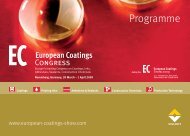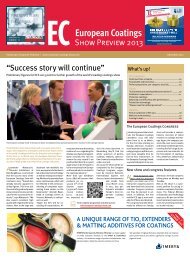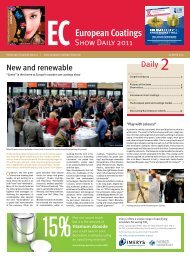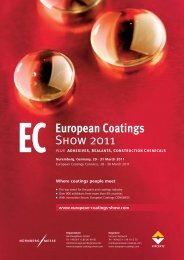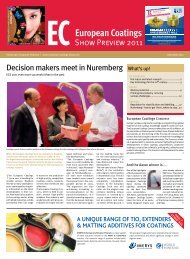You also want an ePaper? Increase the reach of your titles
YUMPU automatically turns print PDFs into web optimized ePapers that Google loves.
Focus<br />
10<br />
Clever ways to achieve<br />
better properties<br />
Sessions on smart and functional coatings provide an overview<br />
Smart coatings are often referred to as structured coatings<br />
which confer additional benefits by responding in a defined<br />
manner to external stimuli. Much talked-about are self-healing,<br />
anti-fingerprint and conductive coatings, to name but a<br />
few. These materials are clearly still attracting ever-increasing<br />
levels of attention.<br />
Attendees at the Co n g r e s s<br />
sessions on smart coatings<br />
and functional materials<br />
will be given an overview<br />
of current developments in<br />
these systems. A flavour of<br />
some of the twelve presentations<br />
is provided below.<br />
Carbon nanotubes (CNTs),<br />
for instance, are very promising<br />
substances. Tiny as<br />
they are, these molecularscale<br />
tubes of graphitic<br />
carbon can help improve<br />
both the mechanical and the<br />
electronic properties of materials.<br />
Two presentations<br />
are dedicated to these excit-<br />
“In principle, anything is possible”<br />
Prof. Claus D. Eisenbach, Dutch<br />
Polymer Institute/ Institute for<br />
Polymer Chemistry, University of<br />
Stuttgart<br />
Prof. Claus D. Eisenbach, Scientific Chairman, <strong>Coatings</strong><br />
Technology Area, Dutch Polymer Institute, and Institute for<br />
Polymer Chemistry, University of Stuttgart, comments on the<br />
latest trends in smart coatings.<br />
� How do you define “smart<br />
coatings”? What makes a<br />
coating “smart”?<br />
Claus D. Eisenbach: The<br />
term “smart coating” is<br />
most probably derived<br />
from “smart materials.”<br />
In applied technology, the<br />
adjective “smart” generally<br />
characterises the response<br />
of a material’s properties<br />
to a stimulus. So, a “smart<br />
ing substances. Dr. Michael<br />
Berkei of Byk Chemie will<br />
discuss conductive coatings<br />
that contain carbon nanotubes.<br />
He will present new<br />
additives based on CNTs<br />
that are capable of functionalising<br />
coatings in respect<br />
of conductivity.<br />
Prof. Jeon Kook Lee, Korea<br />
Institute of Science and Technology,<br />
will talk about electrical<br />
conductivity improvement,<br />
with a focus on transparent<br />
conductive carbon nanotube<br />
films which are made by a<br />
solution spray process.<br />
coating” will respond to an<br />
external stimulus such as<br />
light, temperature, pressure,<br />
pH, odors & gas. The<br />
stimulus causes a change<br />
in the coating’s properties.<br />
This chemical or physical<br />
change may be reversible or<br />
irreversible in accordance<br />
with the special coating<br />
system and/or intended application.<br />
<strong>European</strong> <strong>Coatings</strong> Show Preview December 2010 www.european-coatings-show.com<br />
Dr. Mat thias Wanner of Fraunhofer<br />
Institute for Manufacturing<br />
Engineering and Automation<br />
will address novel<br />
self-cleaning coatings. The<br />
project he is currently involved<br />
in seeks to generate<br />
surfaces which possess selfcleaning<br />
properties and which<br />
are less prone to scratching<br />
or vulnerable to contact with<br />
surfactants.<br />
PFPE silanes to<br />
reduce fingerprints<br />
Surfaces which are routinely<br />
touched in use commonly become<br />
covered in fingerprints,<br />
skin oil, sweat, dirt and cosmetics<br />
– all of which are hard<br />
to remove. Ongoing developments<br />
in fluorosiliconemodified<br />
surfaces are aimed<br />
at conferring easy-to-clean<br />
and stay-clean properties.<br />
� What are the latest material<br />
trends in these coatings?<br />
Eisenbach: There are many<br />
examples where the term<br />
“smart coating” is used to<br />
distinguish such coatings<br />
from conventional protective<br />
or decorative coatings. At<br />
present, research and development<br />
efforts are focused<br />
on different areas. There are<br />
some coatings which exhibit<br />
self-healing properties in response<br />
to mechanical dam-<br />
�<br />
Source: Dutch Polymer Institute<br />
Smart materials are attracting everincreasing<br />
levels of attention<br />
Perfluoropolyether (PFPE) silanes<br />
are suitable for use on<br />
age and others which have<br />
light- or moisture-induced<br />
self-cleaning properties.<br />
Studies are also being done<br />
on coatings with photochromic<br />
and/or thermochromic<br />
properties that change colour<br />
upon exposure to radiation<br />
or temperature, and on<br />
pH-sensitive coatings that<br />
shrink or expand and may<br />
even release low-molecular<br />
substances when the pH in<br />
its environment changes.<br />
Find complete programme and abstracts at:<br />
www.european-coatings-show.com<br />
many substrates and are designed<br />
to reduce fingerprints<br />
and contamination with dirt.<br />
Steve Block of Dow Corning<br />
will discuss improvements in<br />
the PFPE silane polymer structure-property<br />
relationship<br />
and how application methods<br />
affect surface behaviour.<br />
Dr. Melindas Wales, Reactive<br />
Surfaces, will concentrate on<br />
re-chargeable coatings based<br />
on natural biomaterials. She<br />
will detail the current state of<br />
research in the development<br />
of biomaterials for functional<br />
coatings, including antifouling<br />
and antimicrobial surfaces,<br />
and will provide specific<br />
examples of recharging.<br />
Sustainable coatings will also<br />
be discussed by Dr. Frank<br />
Sau er of Lanxess Deutschland,<br />
who will talk about latest<br />
developments on slow-release<br />
techniques for biocides.<br />
❘❚<br />
� What further functionalities<br />
might be feasible in the<br />
near future?<br />
Eisenbach: In principle, anything<br />
is possible. Protective<br />
coatings which adapt<br />
to environmental and/or<br />
service conditions are as<br />
conceivable as coatings for<br />
use in medical diagnostics<br />
(e.g., test strips) and implants.<br />
<strong>Coatings</strong> possessing<br />
special optoelectronic and<br />
electronic properties could<br />
be employed in electronic<br />
devices and information<br />
technology. ❘❚






